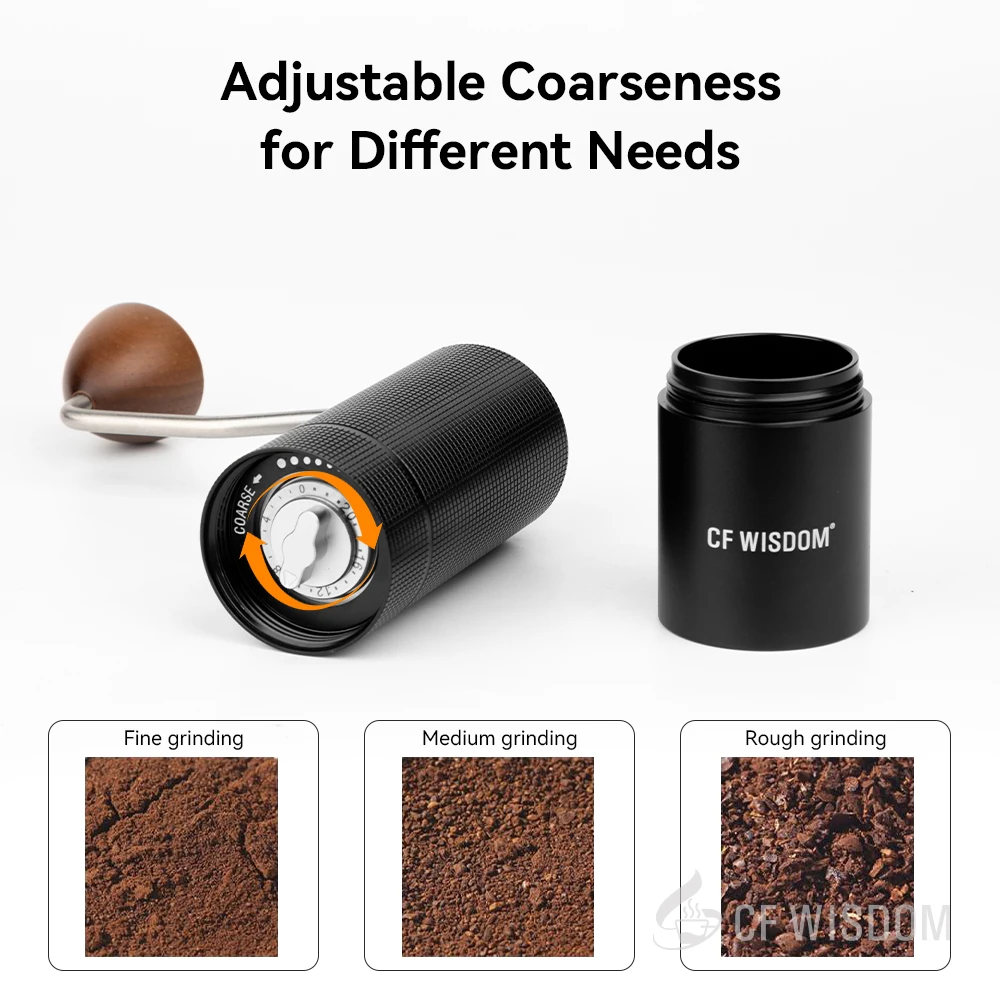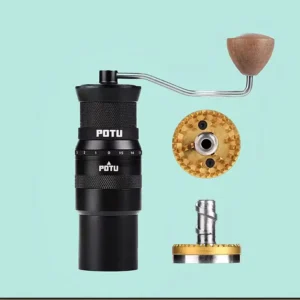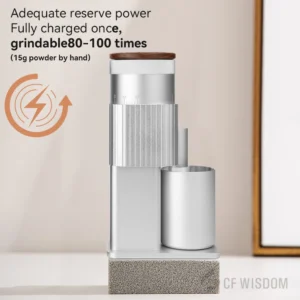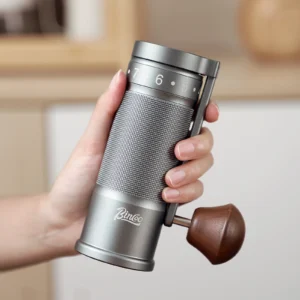Finding Your Ideal Grind Size for AeroPress with a Hand Grinder
The secret to a delicious cup of AeroPress coffee begins long before you add hot water. It starts with your grind size. When brewing with an AeroPress, the grind size directly affects how water flows through the coffee, how much pressure you’ll need to apply, and ultimately, how your coffee will taste.
Hand grinding offers unique benefits for AeroPress users. Unlike electric grinders, which can sometimes heat up the beans and create inconsistent particles, a quality hand grinder gives you exceptional control over the grinding process. This control is particularly important for AeroPress brewing, which thrives on precision.
What makes hand grinders different? They typically use burr grinding mechanisms that crush beans between two surfaces rather than chopping them with blades. This creates a more consistent grind size, which leads to even extraction and better flavor in your cup.
In this comprehensive guide, you’ll learn:
– How to identify the perfect grind size for different AeroPress methods
– Specific settings for popular hand grinder models
– Techniques to improve grinding consistency
– How to troubleshoot common grinding issues
– Ways to fine-tune your grind based on taste
The ritual of hand grinding adds something special to your coffee experience too. Many coffee enthusiasts find that the extra few minutes spent manually grinding their beans connects them more deeply to the brewing process, enhancing their appreciation for the final cup.
The difference between a well-ground and poorly-ground batch can be dramatic. World AeroPress Championship competitors understand this well, with many recipes specifying exact grind settings to achieve perfect extraction percentages. Just a small adjustment in grind size can change extraction rates by 5-10%, completely transforming your cup’s flavor profile.
Understanding various precision grind settings is essential for brewing excellence, whether you’re making AeroPress or other coffee styles. Your journey to the perfect cup begins with selecting the right tools, and many coffee enthusiasts find that portable coffee hand grinders offer the ideal balance of precision and convenience for AeroPress brewing.
The Ideal AeroPress Grind Size: Medium-Fine as Your Starting Point
When brewing with an AeroPress, medium-fine is your sweet spot for grinding coffee. This grind size strikes the perfect balance between extraction efficiency and flow rate, allowing you to capture rich flavors without creating excessive resistance during pressing.
What exactly does medium-fine look like? Imagine table salt or fine sand between your fingers. The particles should be smaller than traditional drip coffee grounds but not as fine as espresso powder. When you rub the grounds between your fingers, they should feel somewhat gritty but not powdery or chunky.
This medium-fine grind works so well with AeroPress because of the brewing method’s unique combination of immersion and pressure. The grounds need to be fine enough to extract quickly during the short steeping period but not so fine that they create too much resistance or produce muddy coffee.
The science behind this recommendation relates to surface area exposure. The finer you grind coffee, the more surface area is exposed to water, allowing for faster extraction of flavors and compounds. With the AeroPress’s short brew time (typically 1-2 minutes), you need enough surface area for proper extraction, which the medium-fine grind provides.
Remember that this recommendation is just your starting point. As you become more familiar with your AeroPress and personal taste preferences, you might adjust slightly finer or coarser. For reference, understanding different coffee grind sizes can be helpful, which is why many brewers consult comprehensive grind size charts when dialing in their perfect setting.
How Different AeroPress Methods Affect Your Grind Choice
Your brewing technique directly influences your ideal grind size. Here’s how to adjust your grind for various AeroPress methods:
Standard Method vs. Inverted Method
The standard method (filter cap down) typically benefits from a slightly finer grind since the coffee has less contact time with water before it begins dripping through. The inverted method allows for complete immersion brewing, giving you more flexibility with grind size – you can go slightly coarser since extraction time is fully controlled.
Brewing Time Considerations
– Shorter brews (30-60 seconds): Use finer grinds to extract quickly
– Longer brews (2+ minutes): Use coarser grinds to avoid over-extraction
Concentration Variations
For concentrated “espresso-style” AeroPress shots, a finer grind (almost espresso-like) creates rich, intense flavors. For diluted Americano-style brews, a medium grind provides balanced extraction that holds up well when added to water.
| AeroPress Method | Brew Time | Recommended Grind |
|---|---|---|
| Standard Method | 1-1.5 minutes | Medium-fine |
| Inverted Method | 1.5-2 minutes | Medium |
| Quick Shot | 30 seconds | Fine |
| Competition Recipe | Variable | Medium-fine to fine |
| Cold Brew | 24 hours | Medium-coarse |
Water temperature also plays a crucial role in determining your optimal grind. When using hotter water (200-205°F), you can grind slightly coarser since extraction happens more rapidly. Cooler water (175-185°F) pairs better with finer grinds to ensure proper extraction despite the lower temperature.
Many award-winning AeroPress recipes feature specific grind requirements. For example, some champions use surprisingly coarse grinds with longer steep times, while others opt for fine grinds with quick, high-pressure plunges. Understanding these variations gives you the knowledge to experiment with your own brewing style.
For those wanting to explore further, our AeroPress-specific grinder guide offers detailed recommendations for getting the most from your manual grinder with this versatile brewing method.
Understanding Your Hand Grinder’s Adjustment System
Before you can dial in the perfect setting, you need to understand how your hand grinder adjusts. Most quality hand grinders use one of these adjustment mechanisms:
Click Adjustment Systems
– Feature distinct “clicks” when you turn the adjustment dial
– Each click represents a measurable step in grind size
– Makes repeatability easier—just count the clicks from zero point
– Common on brands like Timemore, 1Zpresso, and Comandante
Stepless Adjustment Systems
– Allow infinite adjustment between finest and coarsest settings
– Provide ultimate precision but can be harder to replicate exactly
– Usually found on higher-end hand grinders
– Require careful marking or noting of positions
Numbered Dial Systems
– Feature numerical markings on the adjustment dial
– Allow for easy reference and repeatability
– Common on entry-level to mid-range grinders
Finding your grinder’s “zero point” is crucial for consistent settings. The zero point is where the burrs just begin to touch each other. To find it:
- Adjust your grinder to the finest setting
- Turn the adjustment knob slowly until you hear/feel the burrs lightly touching
- This is your zero point—all your settings will be measured from here
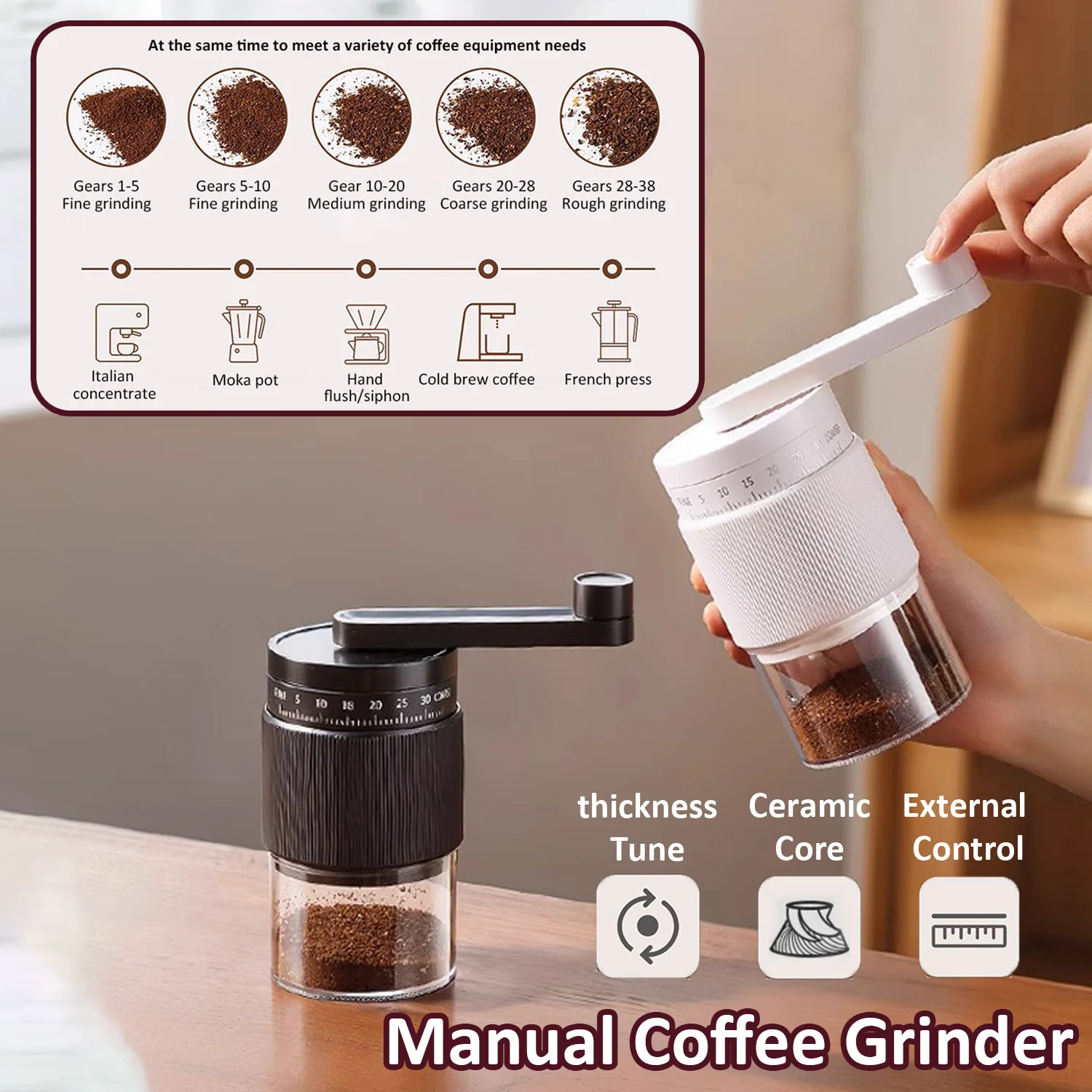
The difference between stepped and stepless adjustment is important. Stepped systems have predefined settings, making them more consistent but less precise. Stepless systems allow for infinite adjustments but may be harder to reproduce exactly each time.
Proper grinder calibration ensures consistency in your brewing. Taking time to understand your specific adjustment mechanism will pay off with better, more reliable coffee every time you brew with your AeroPress.
Optimal Settings for Popular Hand Grinder Models
Finding the right setting for your specific hand grinder can save you time and coffee. Here’s a comprehensive guide to AeroPress settings for popular models:
| Grinder Model | Recommended Setting for AeroPress | Notes |
|---|---|---|
| Timemore C2/C3 | 12-15 clicks from zero | Excellent entry-level option with good consistency |
| 1Zpresso JX | 24-28 clicks from zero | Exceptional value with premium grinding performance |
| 1Zpresso K-Plus | 4.5-5.0 on the dial | Features external adjustment for easy repeatability |
| Comandante C40 | 15-18 clicks from zero | Industry benchmark with exceptional grind quality |
| Porlex Mini/Tall | 5-7 clicks from zero | Compact option good for travel, fewer click positions |
| Hario Mini/Skerton Pro | 7-9 clicks from zero | May need additional consistency mods for best results |
| Kingrinder K4/K6 | 3.0-3.5 rotations | Great value option with premium burr quality |
| Normcore V2 | 8-10 clicks from zero | Good budget option with surprising consistency |
Remember that these are starting recommendations. Different coffee beans, roast levels, and personal preferences may require adjustments to these settings. Lighter roasts often benefit from slightly finer settings, while darker roasts may work better with coarser grinds.
The burr type in your grinder also impacts performance. Steel burrs typically produce more consistent medium-fine grinds ideal for AeroPress, while ceramic burrs may perform better for coarser settings. Conical burrs (most common in hand grinders) create a bimodal distribution that works well for most brewing methods, including AeroPress.
Our collection of manual coffee burr grinders includes options specifically engineered for achieving the perfect AeroPress grind, with precision adjustment mechanisms that help you consistently hit that ideal medium-fine setting.
Perfect Hand Grinding Technique for Consistent Results
Your grinding technique is just as important as having the right settings. Here’s how to achieve consistent results every time:
Bean Loading: Fill the hopper about half to three-quarters full. Overfilling creates uneven pressure on the burrs while too few beans can cause “popcorning” (beans bouncing around).
Stabilize Your Grinder: Place your hand grinder on a non-slip surface or between your knees when seated. Your non-dominant hand should firmly hold the body while your dominant hand cranks.
Find Your Rhythm: Maintain a moderate, consistent speed. Too fast can create heat and inconsistency; too slow is inefficient. Aim for about two rotations per second.
Body Position: Keep your wrist straight and use your entire arm for rotation, not just your wrist. This reduces fatigue and improves consistency.
Listen and Feel: Pay attention to the sound and resistance. Grinding should feel smooth and consistent. Sudden changes in sound or resistance may indicate issues.
Signs of poor technique include widely varying particle sizes, unusually long grinding times, or coffee that tastes inconsistent batch to batch. With practice, grinding 15-18 grams for AeroPress should take 30-60 seconds depending on your grinder and settings.
Understanding all the factors affecting grind consistency can help you troubleshoot when things aren’t working right. Factors like bean freshness, grinder quality, and technique all contribute to your final result.
Fine-Tuning Your Grind: Adjusting Based on Taste
The true test of your grind setting is in the cup. Here’s how to adjust based on taste:
If your coffee tastes sour, weak, or watery:
– Your grind is likely too coarse
– Extraction is happening too quickly
– Adjust one click finer and try again
If your coffee tastes bitter, harsh, or muddy:
– Your grind is likely too fine
– Over-extraction is occurring
– Adjust one click coarser and try again
The Dialing-In Process:
1. Start with the recommended setting for your grinder
2. Brew and evaluate taste
3. Make small, incremental adjustments (one click at a time)
4. Keep notes on settings, brew parameters, and taste results
5. Repeat until you find your sweet spot
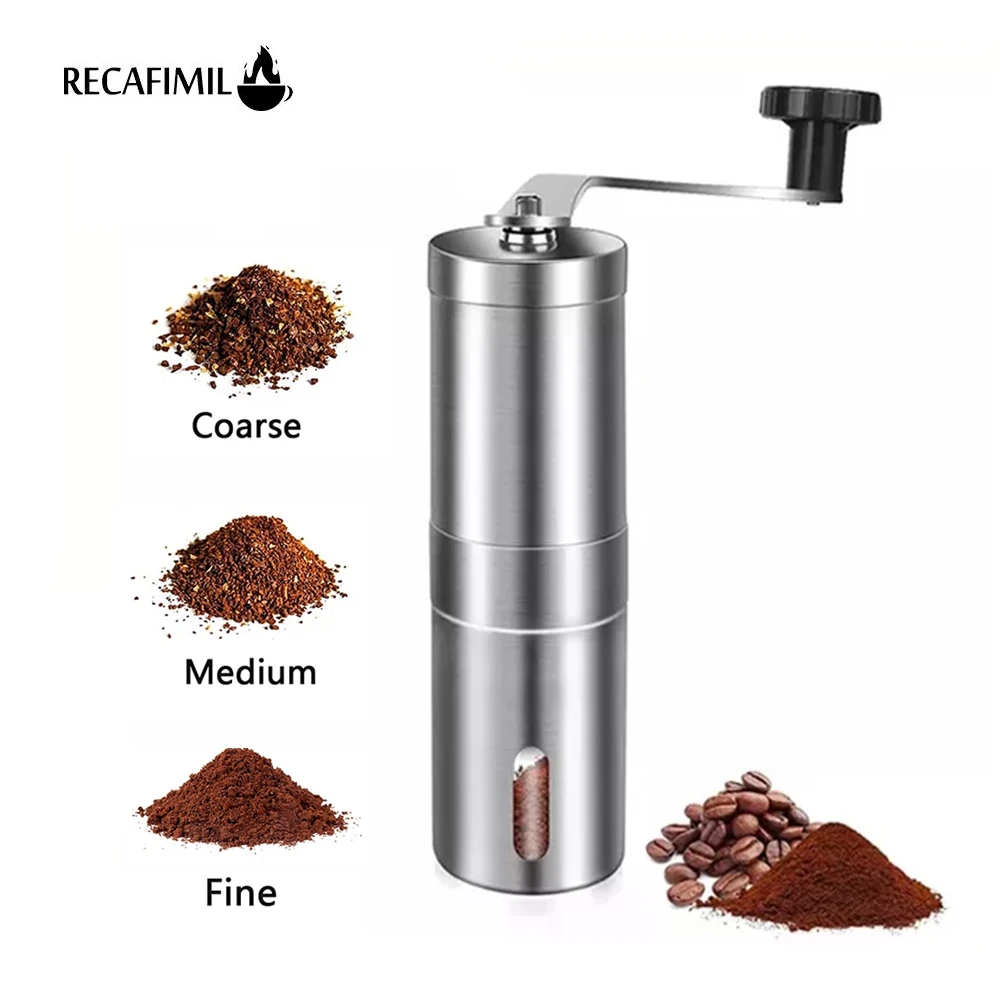
Understanding extraction science helps here: the first compounds to extract from coffee are fruity acids (contributing sourness), followed by sugars and other pleasant flavors, and finally bitter compounds. Your goal is to extract enough of the good flavors without pulling too many bitter compounds.
Many coffee enthusiasts keep a small notebook tracking their grind settings, brew parameters, and taste results. This approach allows you to replicate successful brews and continually refine your technique. The principles applied when dialing in espresso settings are remarkably similar to finding your perfect AeroPress grind—it’s all about making small, deliberate adjustments based on taste feedback.
Troubleshooting Common AeroPress Grinding Issues
Even experienced brewers encounter problems. Here are solutions to common AeroPress grinding challenges:
Inconsistent Grind Particles
– Problem: Coffee grounds varying widely in size
– Solution: Check burr alignment, ensure grinder is assembled correctly, and maintain consistent grinding technique
– Impact: Uneven extraction leading to both sour and bitter notes simultaneously
Excessive Resistance When Plunging
– Problem: Extremely difficult to press the AeroPress
– Solution: Grind slightly coarser, use less coffee, or reduce brewing time
– Impact: Risk of breaking the AeroPress or creating channels that lead to under-extraction
Muddy/Silty Coffee
– Problem: Sediment in your final cup
– Solution: Ensure paper filter is seated properly, pre-wet filter, or use two filters stacked together
– Impact: Unpleasant mouthfeel and potential over-extraction from fines
Weak or Flat-Tasting Coffee
– Problem: Lacking flavor intensity or complexity
– Solution: Grind finer, increase coffee dose, or extend brew time
– Impact: Unsatisfying cup lacking the full potential of your beans
Excessive Fines in Your Brew
– Problem: Too many very small particles clogging filter
– Solution: Consider upgrading your grinder, check burr alignment, or try filtering grounds with a fine mesh before brewing
– Impact: Over-extraction and potential channeling during brewing
Regular maintenance of your grinder is crucial for consistent results. Periodically disassembling and cleaning your grinder can resolve many inconsistency issues.
For those who travel frequently, travel coffee grinders are specially designed to maintain consistency while being compact enough to pack alongside your AeroPress.
What Makes a Quality Hand Grinder for AeroPress
Not all hand grinders are created equal when it comes to AeroPress brewing. Here are the features that matter most:
Burr Material and Quality
Steel burrs typically outperform ceramic for AeroPress’s medium-fine grind range. Steel stays sharper longer and produces more consistent particles, though quality ceramic burrs can still perform well.
Stability and Alignment
A well-designed grinder minimizes wobble in the central shaft and maintains precise burr alignment. This dramatically improves grind consistency, especially at the medium-fine settings ideal for AeroPress.
Adjustment Precision
Look for grinders with enough adjustment steps to dial in the perfect medium-fine grind. Premium grinders often feature 30+ distinct settings, giving you greater control.
Grinding Efficiency
A quality grinder should process 15-18 grams of coffee (standard AeroPress dose) in under a minute without requiring excessive force. This comes down to burr design, bearing quality, and overall engineering.
Build Quality and Materials
Grinders with metal bodies, precision-machined components, and quality bearings will produce more consistent results and last longer than plastic alternatives.
Portability Considerations
If you travel with your AeroPress, consider a grinder’s size, weight, and whether it can be easily disassembled for packing. Some models are designed specifically with portability in mind.
Our selection of precision manual grinders features options specifically chosen for their ability to produce the consistent medium-fine grind that AeroPress brewing demands.
Fine Adjustment Hand Grinder, Precision Manual Grinder, Travel Coffee Grinder
Price range: $185.11 through $494.63 Select options This product has multiple variants. The options may be chosen on the product pageHand Burr Grinder, Hand Crank Coffee Grinder, Manual Espresso Grinder, Portable Coffee Grinder
Price range: $262.72 through $300.22 Select options This product has multiple variants. The options may be chosen on the product pageManual Burr Mill, Manual Coffee Grinder Stainless Steel, Manual Coffee Mill Grinder, Mechanical Coffee Grinder
Price range: $127.26 through $130.32 Select options This product has multiple variants. The options may be chosen on the product pageHand Burr Grinder, Manual Coffee Grinder Stainless Steel, Precision Manual Grinder
Price range: $183.64 through $187.52 Select options This product has multiple variants. The options may be chosen on the product page
Frequently Asked Questions About Hand Grinding for AeroPress
How much coffee should I grind for a standard AeroPress recipe?
Most standard AeroPress recipes call for 15-18 grams of coffee. This is approximately 2-3 tablespoons, though measuring by weight will give you more consistent results. For a stronger brew, you can use up to 20 grams, while recipes aiming for clarity might use as little as 12 grams.
How long should it take to hand-grind coffee for AeroPress?
With a quality hand grinder set to medium-fine, grinding 15-18 grams should take approximately 45-60 seconds of consistent cranking. Lower quality grinders may take 1-2 minutes, while premium models might complete the job in 30-45 seconds.
Can I use pre-ground coffee in my AeroPress?
While freshly ground coffee will always produce superior results, pre-ground coffee can work in a pinch. Look for coffee ground for drip brewing, which is close to the medium-fine consistency ideal for AeroPress. You may need to adjust your brewing time slightly (usually shorter) to compensate for the typically finer commercial grind.
How do different roast levels affect grind settings?
As a general rule:
– Light roasts benefit from a slightly finer grind as they’re harder and more dense
– Dark roasts extract more easily and typically work better with a slightly coarser grind
– Medium roasts usually perform well at the standard recommended settings
How can I make hand grinding easier?
Try holding the grinder between your knees while seated for stability, using your dominant hand for cranking and non-dominant hand to stabilize. Some people find slightly dampening beans (a drop of water per 30 grams) reduces static and makes grinding smoother, though this isn’t recommended for all grinders.
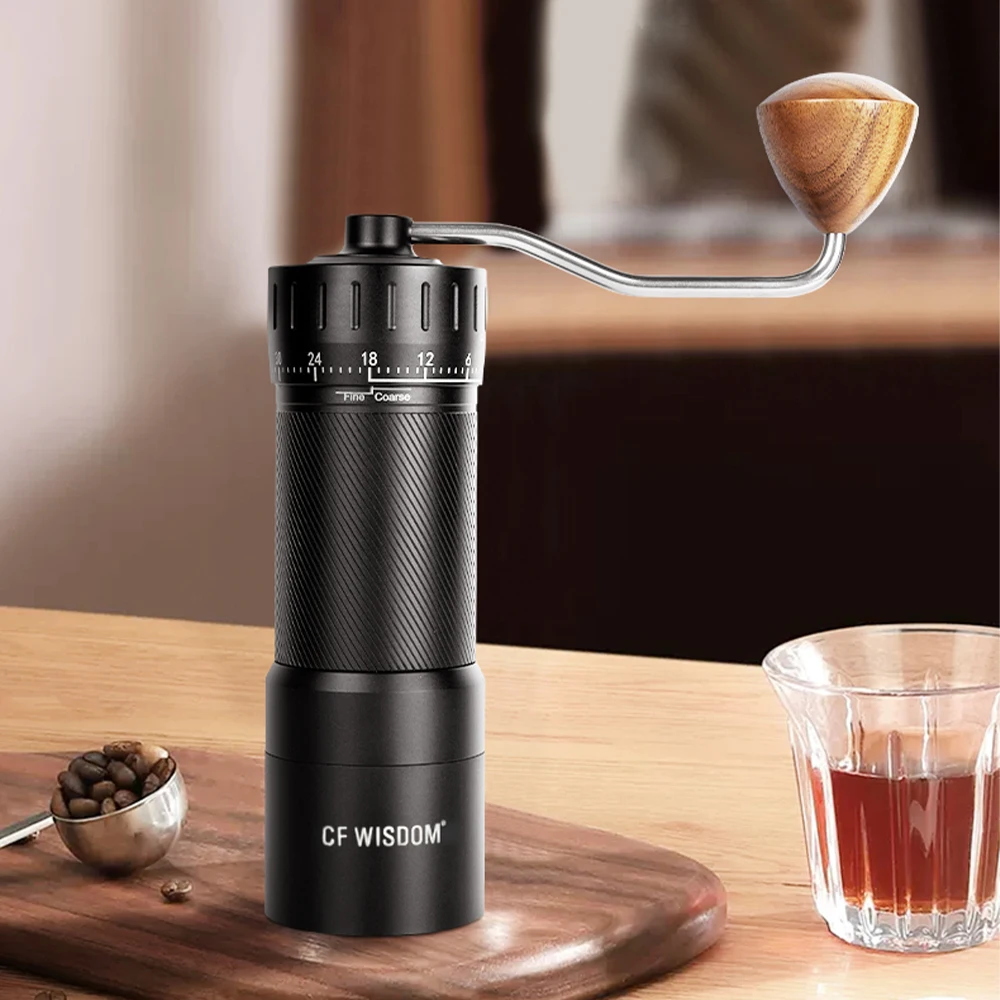
For those interested in understanding the broader world of coffee grinding, comparing manual and automatic grinder settings can provide valuable insights into how different equipment affects your brewing process.
The Importance of Regular Hand Grinder Maintenance
A well-maintained grinder produces consistent results cup after cup. Here’s how to keep your hand grinder in top condition:
Daily Maintenance
– Brush out coffee residue after each use
– Wipe down the exterior with a dry cloth
– Keep the adjustment mechanism clean of coffee oils and particles
Weekly Care
– Use a soft brush to clean burrs more thoroughly
– Check for any beans stuck in the hopper or grinding chamber
– Ensure the handle is secure and properly aligned
Monthly Deep Clean
– Disassemble the grinder according to manufacturer instructions
– Clean each component thoroughly, focusing on the burrs
– Remove coffee oils with a grinder-specific cleaner or uncooked rice method
– Check for burr wear or damage
– Reassemble carefully, ensuring proper alignment
Signs Your Grinder Needs Attention
– Inconsistent grind sizes
– Unusual noises during grinding
– Increased effort required to grind
– Coffee particles getting stuck in the mechanism
– Difficulty adjusting grind settings
The “rice method” for cleaning involves grinding a small amount of uncooked rice to absorb oils and clean the burrs, though check your manufacturer’s recommendations as some don’t recommend this for certain grinder types.
Proper maintenance directly affects your coffee quality. A clean grinder with well-maintained burrs will produce more consistent particles, leading to better extraction and tastier AeroPress coffee. For detailed guidance on keeping your equipment in top shape, our guide to hand grinder cleaning frequency provides comprehensive maintenance schedules.
Experiment and Perfect Your AeroPress Grinding Routine
Finding your perfect AeroPress grind setting is a journey, not a destination. The recommendations in this guide provide an excellent starting point, but your ideal setting will ultimately depend on your specific taste preferences, coffee beans, and brewing style.
We encourage you to keep a coffee journal recording your grind settings, brew parameters, and tasting notes. This simple practice can dramatically accelerate your coffee learning curve. Try adjusting one variable at a time—first find your ideal grind size, then experiment with brew time, water temperature, or brewing ratio.
Remember that different coffee beans may require different grind settings. Lighter roasts often benefit from slightly finer grinds to increase extraction, while darker roasts may taste better with slightly coarser settings to prevent over-extraction.
The hand grinding process is part of what makes AeroPress brewing so rewarding. There’s something meditative about manually grinding fresh beans, smelling their aroma, and then crafting a perfect cup. This hands-on approach connects you more deeply to your coffee experience.
As you continue experimenting, you’ll develop an intuitive understanding of how grind size affects your brew. Soon you’ll be adjusting your grinder with confidence, knowing exactly how each change will influence your cup.
Happy grinding and even happier brewing!

